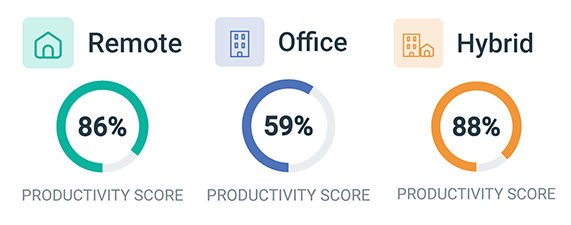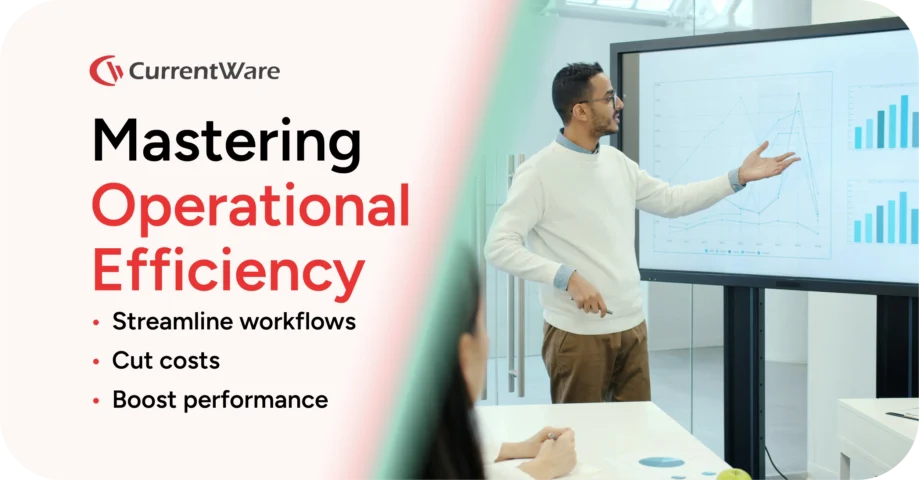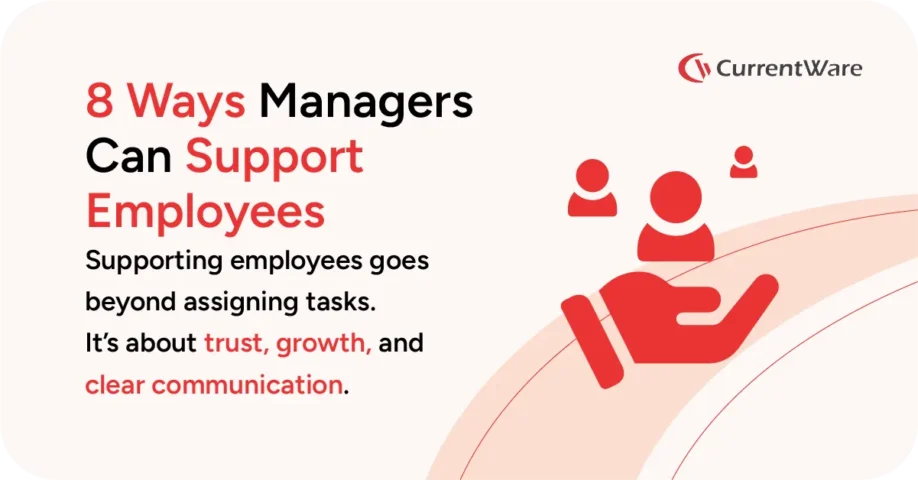How to Get Buy-In for Employee Tracking Software (Critical Tips)
Want to introduce employee tracking software to your company? A successful deployment requires buy-in from your key stakeholders; your employees, business leaders, and software administrators.
In this guide, you will learn the benefits of monitoring employees, how to evaluate employee monitoring tool vendors, and what you need to do to get buy-in for employee monitoring from all levels of your organization.
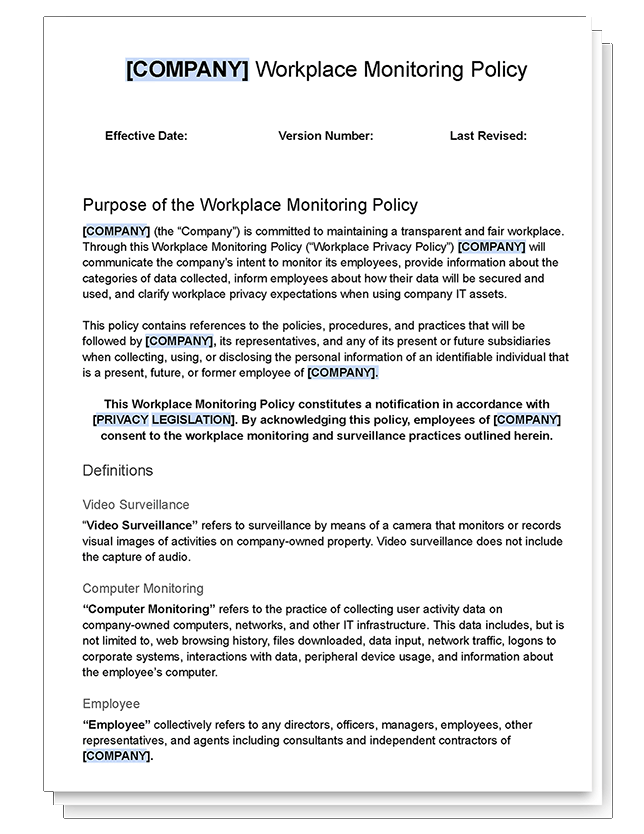
Get Your FREE Employee Monitoring Starter Kit
This kit provides your organization with the tools it needs to implement a successful employee monitoring strategy.
- Templates for policies and disclosures
- Presentations for key stakeholders
- Best practices for monitoring employees
Get started today—Download the FREE kit to get the most out of your organization’s employee monitoring solutions.
Key Takeaways
- Employee monitoring software is not without its risks. You need to consider the pros and cons of employee monitoring to see if it’s the best fit for your business.
- Buy-in for new software starts from the top. Be prepared to address business requirements such as workplace privacy expectations, the ROI of monitoring employees, and the suitability of the vendors you shortlist.
- You need to understand your business objectives. Monitoring employees without a clear purpose in mind will reduce your ROI and frustrate your employees.
- If employee buy-in is important to you, consult them early. Employees may have negative assumptions about tracking software; consult them in the planning process to mitigate these issues and have their voices heard.
- Be transparent and fair about employee monitoring. Covert monitoring damages trust and subjects employees to undue stress. Set clear employee privacy expectations by being above-board about what is being monitored and why.
- What Is Employee Monitoring Software?
- What Are the Benefits of Monitoring Employees in the Workplace?
- Why Buy-In Is Essential When Monitoring Employees in the Workplace
- How to Get Employee Buy-in for Activity Tracking Software
- Understand the Potential Concerns Employees May Have
- Collect Feedback From Employees
- Be Transparent About Workplace Monitoring
- Avoid Invasive Employee Monitoring
- Avoid Micromanaging Employee Productivity
- Don’t Make Employee Performance Monitoring a Competition
- Avoid Automated Decision Making
- Keep Employee Activity Data Secure
- How to Introduce Employee Tracking Software to Your Company
- 1) Plan Business Objectives & Parameters
- 2) Get Buy-In from the Board & Management
- 3) Consult With Your Employees
- 4) Create a Shortlist of Employee Tracking Software Vendors
- 5) Start Monitoring Your Employees
- 6) Collect Feedback & Evaluate the Impact
- Conclusion & More Resources
What Is Employee Monitoring Software?
Employee monitoring software is an application that monitors computer activities such as internet and application usage. These workplace monitoring tools are used to enforce company policies, improve employee productivity, and protect against high-risk computer activities.
What Are the Benefits of Monitoring Employees in the Workplace?
Note: The above video showcases a legacy user interface for BrowseReporter. To see the most up-to-date features and interface please visit the BrowseReporter product page
“To help control the risk of litigation, security breaches, and other electronic disasters, employers should take advantage of monitoring and blocking technology to battle people problems—including the accidental and intentional misuse of computer systems and other electronic resources.”
Nancy Flynn, Executive Director of The ePolicy Institute
Improved Employee Productivity

Employee monitoring software collects valuable workforce analytics data that provides insights into employee work habits. Employee productivity monitoring help managers and other business leaders make data-informed management decisions.
How does an employee monitoring solution improve employee productivity?
- Workflow inefficiencies can be identified and optimized
- The behavior of actively disengaged employees can be discovered and corrected
- Employees can use their data to improve their productivity
- Employee attendance can be tracked to ensure that in-office and remote employees are starting and ending their shifts at agreed-upon times
Greater Capital Efficiency
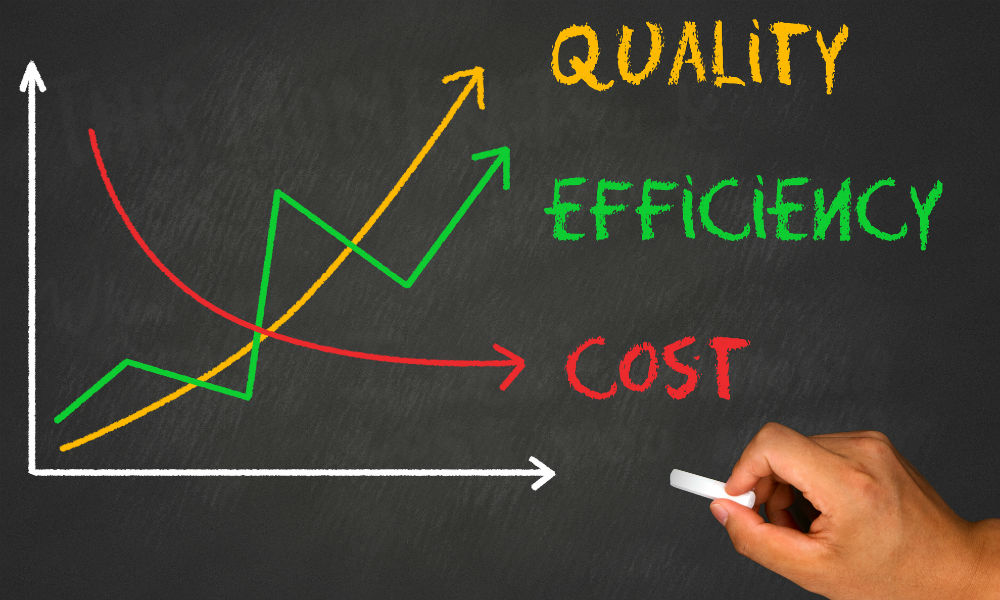
Employee monitoring software improves capital efficiency in two key ways: By helping optimize existing work processes and by reducing software expenses.
1E estimates that as much as 38% of enterprise software is underutilized or simply not being used at all. Worst yet, they found that this underutilized software cost businesses in the US and UK an estimated $34 billion per year.
How can monitoring employee software usage reduce costs?
- Application usage data can be analyzed to see what software needs to be deprovisioned and what software could benefit from additional licenses.
- Redundant software solutions can be identified and consolidated
- Pirated software can be detected before fines from a failed software or security audit are levied against the company
Increased Security

Highly regulated industries such as financial services and healthcare use electronic monitoring software to ensure that their employees comply with company security policies.
Consider this: 58% of data loss events in healthcare involve insiders, making insider threats the single greatest data security threat for the industry.
Without systems to monitor employee computer activity in place your company risks being unaware of an insider data theft incident until it is far too late. The best data loss prevention software will include user activity monitoring features to detect high-risk activity and prevent data leaks.
How does employee monitoring improve security?
- High-risk web browsing behaviors can be detected and addressed
- Unsafe data handling practices can be remedied before they lead to a data breach
- Unauthorized software (shadow IT) can be detected and either substituted with viable solutions or officially adopted
Limit Liability Risks

Employers are liable for the behavior of employees in the workplace. As a business grows it becomes increasingly difficult to maintain visibility into employee work habits.
Employee monitoring software provides an automated means of detecting and deterring undesirable employee computer activities such as software piracy, workplace harassment, and NSFW web browsing before they escalate.
How does employee monitoring limit liability risks?
- It collects evidence of workplace harassment and other high-risk behaviors on company computers
- Employees that know they are being monitored are less likely to engage in inappropriate web browsing
- Insider threats can be detected before they cause a security incident
Why Buy-In for Employee Monitoring Tools Is Essential

Simply put, without buy-in from all levels of your organization you will not be able to reap the benefits of remote employee monitoring software and other employee monitoring tools.
If your board doesn’t understand the ROI of monitoring remote workers, you’ll lack the internal support to implement the software in the first place.
If your managers don’t understand how employee activity data can help them and their employees work more efficiently, they’ll not use the software to its full potential.
If your employees don’t understand how monitoring their work habits is going to benefit them and the business, they’re going to assume it’s being used to spy on them.
The unique perspectives of all of these stakeholders need to be considered when you decide to implement remote employee monitoring software in your organization. Without their support you will not be able to see the full benefits of your proposed solution, or worse; your idea might get shot down altogether.
By prioritizing buy-in on all levels you can ensure that the use of employee monitoring software is well-received by employees, managers, and other key stakeholders.
What happens when you don’t have buy-in from all stakeholders?
- You risk not being allocated the financial resources needed to purchase the employee monitoring software in the first place
- The employee monitoring software will not be used to its full potential, further reducing confidence in the proposed solution
- The workplace satisfaction of employees and managers may suffer, especially if the intent of the monitoring has not been made clear before its implementation

Get Your FREE Employee Monitoring Starter Kit
This kit provides your organization with the tools it needs to implement a successful employee monitoring strategy.
- Templates for policies and disclosures
- Presentations for key stakeholders
- Best practices for monitoring employees
Get started today—Download the FREE kit to get the most out of your organization’s employee monitoring solutions.
How to Get Employee Buy-in for Activity Tracking Software

Employee buy-in is largely influenced by
- The character of the leadership team
- The factors behind their decisions
- The benefits of the decisions have to all stakeholders.
With this in mind, you need to sell your employees on the tangible benefits that employee monitoring software will provide them. They need to trust that their leadership team has their best interests in mind.
This next section will outline exactly what you need to do to build this trust, communicate the benefits of your desired solution, and generate buy-in among your employees.

Get Your FREE Employee Monitoring Starter Kit
This kit provides your organization with the tools it needs to implement a successful employee monitoring strategy.
- Templates for policies and disclosures
- Presentations for key stakeholders
- Best practices for monitoring employees
Get started today—Download the FREE kit to get the most out of your organization’s employee monitoring solutions.
Understand the Potential Concerns Employees May Have

If your company has never previously used employee monitoring software you may not be aware of the potential concerns that remote workers and other employees may have about being monitored.
- Are we being monitored because we’re not trusted to self-manage?
- Are we going to be unfairly scrutinized by constant surveillance?
- Are my contributions going to be downplayed because the monitoring software says I’m not being productive?
- This isn’t going to be used for my benefit; it’s just a piece of computer spy software for snooping on me
- Will us remote workers be judged more harshly than non-remote teams?
Being aware of these potential concerns in advance will help you empathize with remote workers and explain the true value of the tracking software. Provide their managers with the answers to these FAQs in advance and encourage them to follow up with any other questions they get along the way.
Collect Feedback From Employees

To get an accurate picture of employee sentiment, the best practice is to consult with them directly. Explain your intended use of the user activity monitoring software and collect any feedback they may have. Make note of these concerns and provide reassurance about the intended use of the software.
During this process, you must assure your employees that…
- It will not become a lone source for evaluating performance
- It won’t replace management or reduce their impact to mere numbers
- It’s not there to spy on them or enable digital micromanagement
- Its true intention is to protect the business, help managers better support employees, and allemployee tracking softwareow employees to manage their workflows with greater autonomy.
If consulting with each employee is not scalable, consider consulting with a representative sample of employees from a variety of backgrounds. This advisory committee will help advocate for the workplace privacy concerns of employees and provide valuable insights into employee sentiment.
Involving employees in the early planning process provides them with ample opportunity to voice their concerns. It also provides the organization with an opportunity to communicate how monitoring software will be used before rumors and misunderstandings can spread.
Be Transparent About Workplace Monitoring

“If organizations wish to monitor their employees, they should be clear about its purpose and that it brings real benefits. Organizations also need to make employees aware of the nature, extent, and reasons for any monitoring”
Spokesperson from the UK’s Information Commissioner’s Office
Transparency is not legally required in all jurisdictions. That said, if you want to increase employee buy-in for monitoring software you’ll want to avoid secretly monitoring their computer activity.
Employees that are not aware that they are being monitored, why they are being monitored, and how they are being monitored are less likely to find employee monitoring acceptable.
If your employees aren’t clear on how they will be monitored in the workplace they’ll be left to assume the worst—micromanaging bosses spying on their every move, keyloggers capturing private information, audio recording devices eavesdropping on private conversations, you name it.
Fortunately, 84% of employers surveyed by the American Management Association said that they notify their employees that they monitor and review computer activity.
How to increase transparency when monitoring employees
- Have employees sign a workplace privacy policy that outlines what will be monitored, why it is being monitored, and how their data will (and will not) be used
- Provide employees with access to their activity data so they can see exactly what is being captured
- Have the tracking software periodically remind your employees that they are being monitored
- Disclose the scope of employee monitoring during onboarding and within employee handbooks
- Provide employees with a point-of-contact who can field any questions they may have
Many organizations choose to simply disclose their intent to monitor in an acceptable use policy. While this is often proficient from a legal standpoint, the lack of specificity may be concerning to some employees.
For example, an employee may be comfortable having their internet history monitored but they would be devastated to find out that their private social media conversations are being logged. Unless you’ve made it explicitly clear that personal use is prohibited they may not think twice about sending private personal messages during their breaks.

Workplace Monitoring Policy Template
- Disclose your company’s intent to monitor employees in the workplace
- Set workplace privacy expectations for employees
- Meet transparency requirements for compliance with privacy laws
Get started today—Download the FREE template and customize it to fit the needs of your organization.
Avoid Invasive Employee Monitoring

When it comes to monitoring in the workplace, many believe that if an employee is using company equipment, on company time, and getting paid by the company, that the company has every right to monitor their equipment and what the employee is doing with it.
While this is true in the majority of cases, the monitoring of computer activity can still be perceived as invasive in some circumstances. It’s up to business leaders to ensure that employee monitoring software is used ethically and that employee privacy expectations are properly managed.
Factors that influence the perceived invasiveness of employee monitoring
- Lack of Informed Consent: If employees are not clear as to what is being monitored and why they are more likely to speculate beyond the scope of their employer’s intended usage.
- Expectation of Privacy: Even when using a company-owned computer an employee may feel they have some reasonable expectation of privacy. This is especially true if their employer has not disclosed their intent to monitor employee computer activity.
- Personal Use: Monitoring software cannot reliably distinguish between personal and business use. If employees are permitted to use company-owned computers for personal tasks the software could capture intimate personal details such as health status, religion, and ethnicity. Without proper policies and access controls in place, this information could be used in a discriminatory way.
- Misuse of Data: If an employee consents to having their activity monitored for one purpose (such as improving security) and their data is instead used for another purpose (such as evaluating performance) they are likely to feel that they weren’t able to provide informed consent.
- Excessive Monitoring: Monitoring is more likely to be perceived as invasive when the employer collects more information than they reasonably need to meet their intended goals. For example, monitoring individual keystrokes is far more invasive than necessary for enforcing internet use policies vs monitoring internet usage.
- Data Accessibility: Employee monitoring data must not be freely accessible to parties without a legitimate business need for the data. For example, a manager is unlikely to have a reasonable use case for the activity data of an employee from a separate department.
Avoid Micromanaging Employee Productivity

Rutgers psychologist Jack Aiello has extensively studied the effects of computer monitoring on employee performance. He’s found that employees who are monitored and constantly told that they’re not working fast enough have little motivation to improve their work”
Alana Semuels, L.A. Times
Emphasizing independence and autonomy is critical if you will be using tracking software to monitor employee performance. A report from Topia found that 63% of employees defined a great employee experience as being “empowered and trusted to do their job with little supervision.”
When your organization first starts using employee productivity monitoring software your remote employees and in-office staff aren’t going to be ranked as 100% productive. This may tempt managers to crack down on all activities that are labeled as “unproductive” to boost their team’s productivity scores.
Micromanaging employee behavior in this way is going to do more harm than good.
Employee productivity monitoring software is meant to provide a high-level overview of how your employees have spent their time; it is not a replacement for discretion.
It should be used as a tool for employers and employees alike to identify areas of improvement. If monitoring is used to micromanage employees it will further upset the balance of power in the workplace, leading to negative employee sentiment.
If employees feel that monitoring is being used for discipline, micromanagement, and surveillance rather than business intelligence they are far less likely to accept being monitored in the workplace.
Besides, “unproductive” web browsing can increase employee productivity. According to a publication from Brent Coker of the University of Melbourne when “cyberloafing” does not consume more than 12% of an employee’s work time it provides a valuable outlet for managing an employee’s mental energy throughout the day.
“Short and unobtrusive breaks, such as a quick surf of the Internet, enables the mind to rest itself, leading to a higher total net concentration for a days’ work, and as a result, increased productivity.”
Brent Coker, Lecturer of Marketing, University of Melbourne
Key considerations when using employee performance monitoring software
- Understand Its Limits: For most roles, computer activity is not a reliable standalone indicator of productivity. Employees can be engaged in work-adjacent tasks that the monitoring software does not track such as phone calls, deep thinking, in-person meetings, etc.
- Avoid Micromanaging: Unless there are definitive signs of disengagement it’s best to trust your employees to manage their workflows throughout the day. The minor boost in productivity from cracking down on web surfing will quickly become overshadowed by the loss of autonomy and trust.
- Context is Key: What is considered “unproductive” computer activity for one employee may be work-related for another employee. For example, frequently accessing social media sites is normal for a marketing role whereas it may not be expected for a team leader.
Don’t Make Employee Performance Monitoring a Competition

Some employee monitoring software solutions vendors encourage their customers to use employee productivity reports as a leaderboard to encourage engagement and friendly competition.
While it’s true that a bit of friendly competition can provide employees with an incentive to meet critical KPIs, if you take a critical look at what’s being tracked, there’s nothing that can be reliably used.
Here’s what employee monitoring software can track
- Active time: Time spent actively using a web page/app
- Idle time: Time where a web page/app was open but not in use
- Web browsing including URLs, page titles, and the categories of websites visited
- Bandwidth consumption
- Search engine queries
- Time spent on productive vs unproductive websites
While all of these metrics are valuable for understanding how employees spend their time, it’s not a fair comparison for a competition.
Should someone that browses Reddit on their phone all day while wiggling their mouse (so as not to appear idle on their computer) be held in higher regard than someone who spends the majority of their work time focused on high-impact tasks?
Of course not!
Don’t get me wrong, there are legitimate use-cases for employee productivity monitoring—it just doesn’t provide a reliable and fair metric to use in a competition.
If activity tracking software is forcing employees to work in a way that is unnatural to them, they’re not going to react favorably.
Each employee has a different way of working, so if you incentivize “who can spend the least amount of time on social media this week” as your productivity goal it completely ignores the true value of the data—understanding how your employees work.
Avoid Automated Decision Making

Employee monitoring software should be used to inform decisions, not make them.
Computer activity can’t accurately reflect the quality of an employee’s work. For this reason, automated decision-making is strictly prohibited under GDPR.
High-impact decisions such as promotions, job retention, and salary negotiations require careful evaluation from someone that understands the impact the employee makes on the company.
If employees feel that their computer activity data could harm their careers, they aren’t going to support the idea of being monitored in the workplace.
That said, it’s important to clarify what “automated decision-making” means.
For example, you are perfectly fine to use employee monitoring software to alert you when an employee visits an inappropriate website. You can then take this information and use it to issue corrective action after manual review from a qualified representative from the company.
In this example, the alert was issued by the employee tracking system, but the decision to respond to the alert was taken by a human following a review of that data. This is not automated decision-making, so it is perfectly fine.
However, if the employee was automatically punished without due process this would be considered automated decision making.
Without the discretion of a human being, there’s a significant risk that an employee will be unfairly punished—a coworker could have been using their login, the website may have been incorrectly identified as inappropriate, or malware could have forced the employee to visit the inappropriate website.
As there’d be no way of knowing for certain without manual review, the best practice is to use appropriate discretion when interpreting an employee’s computer activity data.
Keep Employee Activity Data Secure
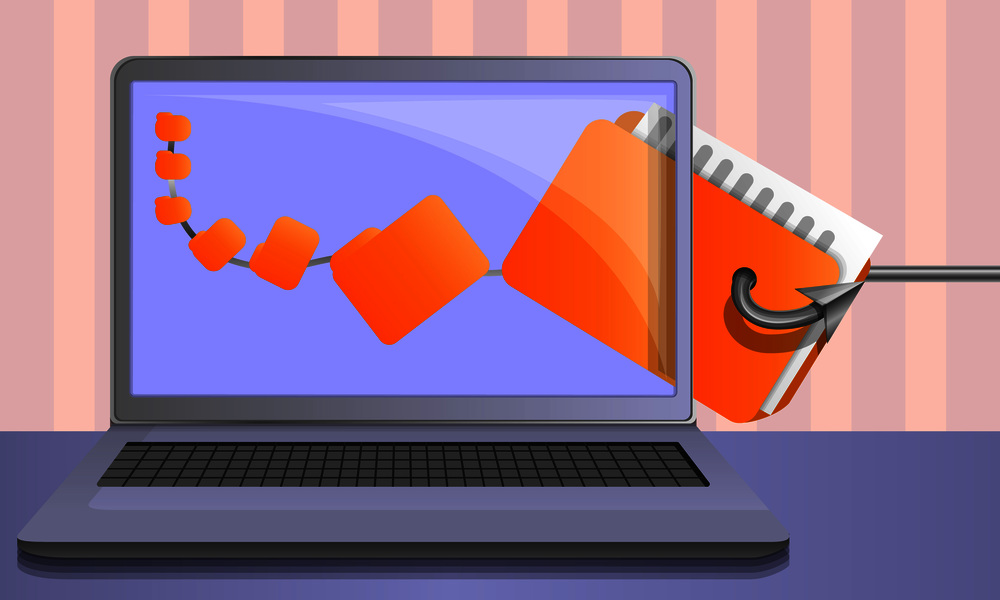
Computer activity data can contain sensitive details about employees. Organizations need to ensure that security measures are in place to prevent their employee’s data from being misused or leaked to unauthorized parties.
Something as simple as an employee’s web browsing history can reveal information about their personal life such as health status, religion, and ethnicity. Even if an employee uses the computer for strictly work-related purposes, their activity data needs to be protected against access from unauthorized parties.
For example, without some form of access control in place, anyone from within the company could access an employee’s data and form negative biases against them. These biases could then influence their day-to-day interactions with the employee.
How to Introduce Employee Monitoring Software to Your Company
The decision to monitor employees should not be taken lightly.
While procurement will be fairly standard, the nature of employee monitoring software is different than that of most programs that are used in the workplace. Companies that intend to monitor employees will benefit from having buy-in from human resources, managers, and employees alike.
Even if you are in a position where you can simply purchase your desired employee monitoring software, install it on your employee’s computers, and call it a day, you may want to consider taking a less top-down approach.
When you take a top-down approach to employee monitoring you risk having employees think the worst:
- “This is just computer spy software that’s going to be used to micromanage how I work and punish me for every little thing”
- “They’re just trying to find a reason to fire me”
- “If they’re monitoring what I do at work it means that they don’t trust me to do a good job”.
Besides, small businesses and large enterprises alike will have key stakeholders that will be affected by business decisions. These stakeholders need to support the direction the business is heading, and the best way to do that is by involving them in the process and presenting your desired solution in the best way possible.
In this section, I will break down the steps you can take to mitigate these negative perceptions, demonstrate the value of employee monitoring software to your key stakeholders, and increase buy-in for monitoring employees in the workplace.
1) Plan Business Objectives & Parameters

Employee monitoring software shouldn’t be used haphazardly. You need a clear understanding of what your organization’s goals are and how monitoring employees will help meet those goals.
What is the most critical business pain point the employee monitoring software will address? If you want business leaders to buy into your proposed solution you need to be prepared to clearly describe the challenge and the solution.
Start by answering these three questions
- Where are we today?
- Where do we want to be?
- How will monitoring our employees help us get there?
If you’re not 100% clear on this yourself, there’s no way that you’ll be able to convince anyone else.
Consider this case study from Shady Maple
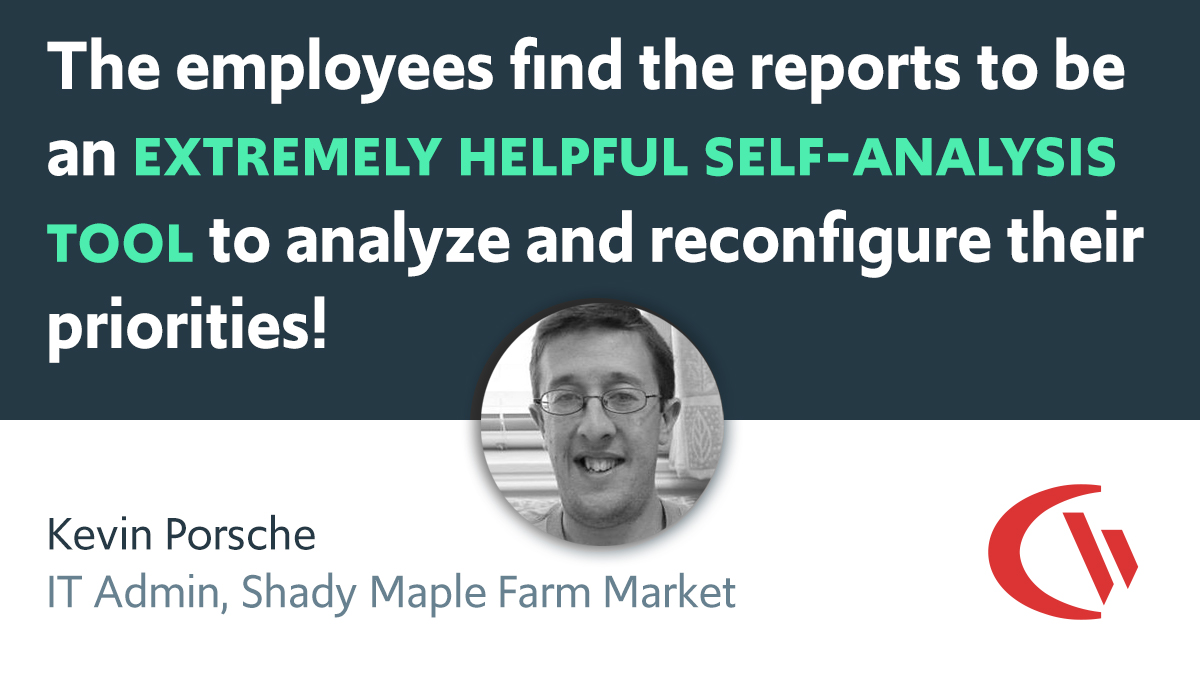
Shady Maple found CurrentWare during a significant period of growth in their company. As they grew they quickly realized that manually checking employee internet browsing history wasn’t a scalable solution for enforcing their acceptable use policy.
So, from Shady Maple’s POV
- Where are we today? We are a small company with limited resources; enforcing our AUPs involves tedious, unreliable, manual review of employee browsing history.
- Where do we want to be? We want to grow our business while keeping our employees productive and our network safe.
- How will employee monitoring help us get there? With automated methods of monitoring employee computer activity for inappropriate use, we can save countless hours of inefficient manual labor and invest that time into higher impact projects.
It’s essential to have a definitive use case for employee monitoring software. Without one, you risk monitoring more than necessary, frustrating employees, and not getting optimal benefits from your chosen solution.
There are also logistical considerations for employee monitoring
- Who will be in charge of managing the solution?
- How will we keep employee data safe from misuse?
- How will the privacy expectations of employees be balanced with the needs of the business?
What You Need to Know Before Implementing Employee Monitoring Software
At this stage, you know the benefits of introducing employee monitoring to your company, but you need to be prepared to get everyone else on board too.
As a change agent in your organization, you need to come prepared with all of the relevant information that your stakeholders will want to know.
- Company Goals: What tangible benefits will the solution bring? How does it align with the company’s goals?
- Features: What data needs to be captured to meet the company’s goals? Are there any other key features that need to be considered?
- Administration: Who will be in charge of managing the solution? Who will have access to employee data? Will reports be checked frequently or on an as-needed basis?
- Data Security: How can you ensure that employee data is secured and only used for its intended purpose? What processes will be in place to limit access to data? Does the vendor of the employee monitoring solution allow for on premises data storage?
- Employee Privacy: How does the use of monitoring software align with our employee’s privacy expectations?
- Financial: Is there room in the budget for the software? Will the software vendor provide incentives such as volume and pre-purchase discounts?
- Workplace Privacy Laws: What processes need to be in place to ensure that the monitoring is done lawfully?
By having thought-out answers to these questions ahead of time you will set yourself up for success when it comes time to propose your solution.
2) Get Buy-In from the Board & Management

So far you’ve felt empowered to identify and promote the need for change in your organization. Now that you have a clear understanding of how employee monitoring software will be used, it’s time to get the other business leaders on board.
This stage of the process is going to be very ROI-driven. Discuss the benefits of monitoring employees, how those benefits compare to the financial costs and the potential impact on the employee experience, and the steps that will be taken to mitigate these risks.
Here’s what you’ll need to support your pitch
- Business Objectives: Present the plan you developed in the previous section to show the use-case and feasibility of employee monitoring software.
- Case Studies: Have other companies benefited from monitoring their employees? What pros and cons did they experience? How are they using the solution?
- Employee Sentiment: Some decision-makers may want to know what employees will think of monitoring before even considering it. How will their perspectives be used to inform the deployment?
- Research: Read employee monitoring white papers, articles, and other materials to collect the information you’ll need to support your decision.
- ROI: If you want business leaders to invest in your proposal, you need to make the benefits immediately clear from the start.
- Rebuttal Handling: Any business decision is going to come with some potential obstacles and challenges. Think about what objections your stakeholders might have and be prepared to address them.
3) Consult With Your Employees

Don’t just tell employees that organizational changes are coming — get their opinion.
The decision to monitor employee computer activity should be taken far more seriously than most other software purchases. Depending on the perspective of individual employees the monitoring may very well have a tangible impact on their wellbeing, particularly if they use workplace computers for personal tasks.
Worst yet, if your employees don’t understand why these changes are happening it leaves room for speculation.
Some organizations use employee monitoring software to micromanage their employees, exert a “Big Brother is watching you” style of workplace surveillance, and monitor their computer activities so they can snoop on them.
This history of unethical behavior has caused some employees to feel that tracking software is a disciplinary technology rather than a workforce analytics tool.
If your intentions aren’t immediately clear they may assume this is your goal. A lack of transparency risks breeding resentment, increasing levels of anxiety, and (ironically) harming employee productivity.
By consulting with your employees before deploying employee monitoring software you can hear their concerns, demonstrate how workplace monitoring will benefit employees, and reassure them that they will be monitored in a way that is in their best interests.
How to involve employees in the decision process
- Involve a representative sample of employees in the planning process
- Gather employee sentiment through informal chats and surveys
- Invite employees to submit their feedback anonymously so that they can be as upfront as possible
4) Find the Best Employee Monitoring Software Vendors

Now that you’ve identified the use case for employee monitoring software in your company, received buy-in from business leaders, and consulted with your employees, it’s time to choose the best employee monitoring software vendor for your business.
Step 1: Identify Business Requirements & Resources

Start by creating a weighted matrix of business requirements that will be used to evaluate each vendor and their monitoring software.
What you include in this matrix will be specific to the needs of your business
- What problem(s) are you trying to solve?
- What features are required to solve the problem(s)?
- What are the “must-haves” and the “nice to haves”?
- Technical requirements such as operating systems, hardware limitations, scalability, etc
- Internal and external support requirements (ease of use, post-sales support, etc)
- What constraints do you have (budgetary, internal resources, etc)?
For more information, check out this article by SoftwareAdvice.com; it includes more information on evaluating software vendors and a handy software comparison chart template to help you find the best employee monitoring software for your business.
Step 2: Research Software Vendors

See reviews of our employee tracking software on Capterra
With your business requirements identified, you’re now prepared to research some of the best employee monitoring software solutions for your organization.
Start by searching for keywords such as “the best employee monitoring software”, “internet monitoring software”, and “computer monitoring software” to find employee and computer monitoring software vendors and independent review platforms.
Look for these key offerings from your vendors
- Employee Monitoring Features & Tech Requirements: How well aligned is their feature set to your list of requirements? Do they meet all of your “must-haves”? Is the software compatible with your environment?
- Customer Support: What level of support is offered? Search for knowledge bases, webinars, 1-on-1 support, onboarding, and post-purchase support options. Are there any added fees associated with customer support? Even the best employee monitoring software can be a poor choice if it’s unsupported.
- Ongoing Development: Regular updates are critical for the best employee monitoring software as they need to remain compatible with the latest web browsers. When was the last time that the product was updated? Is currently being supported with new features, bug fixes, and compatibility updates?
- Case Studies: Are there case studies from organizations that are similar to yours in size, use-case, and environment? Make sure that the case studies are relevant to your environment; what’s the best employee monitoring software for one industry or business size may not be the best employee monitoring software for another.
- Costs: What is the cost of purchasing & maintaining the solution? Are licenses perpetual or subscription? What other costs are associated with the solution? Consider upfront and recurring costs, discounts, and how the costs compare to the ROI.
- Ease of Use: Does the solution seem intuitive to use? If not, will you have staff that can comfortably manage the solution? Internal support requirements can make or break your decision.
- Remote Workforce Management: If you have hybrid or remote employees it’s essential that the employee monitoring solution is compatible with your remote workforce.
- Legal & Privacy Requirements: How much control do you have over what is and is not monitored? The best employee monitoring software will allow you to disable more invasive features so you can stay within compliance of workplace privacy laws and employee privacy expectations
- Free Trial: Does the vendor offer evaluation licenses so you can test out their solution in your actual business environment? While they may appear to be the best employee monitoring software in a demo environment you’ll need to test it on at least a few of your computers to ensure it functions as expected. The trial period is also a great opportunity to test how responsive their customer support is and the level of attention they’ll provide.
Step 3: Create the Shortlist & Renegotiate

With your master list of viable options in hand, it’s time to create a shortlist of the best employee tracking software vendors based on the weighted scores you assigned earlier.
You should ideally refine this list down to the top 3-5 vendors to make the final evaluation process as efficient as possible.
If you have otherwise strong candidates that aren’t making your shortlist out due to financial constraints, consider reaching out to them and renegotiating. While most technology decisions shouldn’t just be based on the lowest bid, you’ll need to consider how well the vendor fits with your budget if you want to get your purchase requests authorized.
How to get discounts on employee monitoring software
- Volume: The more licenses you’ll be purchasing, the greater your negotiating power is. Most vendors will offer volume discounts once you’ve reached a certain threshold.
- Industry: Some vendors offer discounts for educational or non-profit organizations, though they may not advertise it on their site.
- Pre Purchase: Subscription-based vendors will typically offer increasing discounts based on the number of years purchased upfront. Perpetually licensed products will typically offer a similar discount for their maintenance renewals.
Next, take your shortlist of vendors and test out a free trial of their software. Evaluate how intuitive they are to use, the value provided by the reports, how well the software performs in your environment, and your overall impression of the product.
Step 4: Present Your Shortlist

Depending on the software procurement process of your organization, you may need to (once again) get buy-in from the relevant influencers in your organization.
Fortunately, you’re now in the optimal position to justify why the vendor(s) you selected are the best choice.
At this stage, you’ll present your top solutions with examples of positive reviews, relevant case studies, associated costs, ease of implementation, support and training, or other details that matter to each stakeholder.
5) Start Monitoring Your Employees

Now that you’ve found the desired monitoring software, it’s time to see how well your employees respond to being monitored in the workplace. There’s no better way to confirm that employee monitoring is right for your organization than a personalized case study.
At this stage, you will be establishing an in-house focus group that will demonstrate how the monitoring software will be used at scale. This small-scale experiment will help you collect valuable feedback from the people who will be using the employee monitoring software day-to-day: Employees, software administrators, and managers.
As the program progresses, you’ll want to find out…
- How are they benefiting from the monitoring software?
- Are they finding the data valuable?
- Are there any reservations about how the data is being used (or could be used)?
- How well is the software performing? Is it user-friendly enough for your desired administrators to use day-to-day?
A successful pilot program is a valuable internal case study that will help sell the rest of your employees on the solution. This phased approach to implementing the monitoring software will provide non-monitored employees with a preview of the benefits that the monitoring can have.
How to Start Monitoring Your Employees
- Recruit a small sample size of employees and managers to help you test out the monitoring software. Ideally, you’ll have at least two teams from different departments so you can see the impact of the software in different contexts.
- Establish a feedback process for monitoring the impact of the software on your teams. This will help you identify any sticking points that need to be addressed before employees are monitored at-scale
- Appoint someone to take ownership of the reporting process. Will employees be exclusively self-evaluating with their reports or will a manager be making use of the data as well? Try to keep this part of the process as true to its intended use as possible so you can properly evaluate its effectiveness.
- Decide on a suitable cadence for reporting. Will reports be checked daily, weekly, or as-needed?
- Install a free trial of the employee tracking software you will be evaluating. Test the initial functionality of the software to ensure that data is being collected and that the management console is enjoyable to use.
- Monitor the computer activity of your employees for at least 1-2 weeks; this will provide you with enough sample data to see how tracking employee activity can benefit your organization.
How to Use Employee Monitoring Software Reports
- Efficient Workflows: Excessive unproductive web browsing may be a sign that employees are under-allocated or frequently faced with idle time due to external dependencies.
- Overworking Risks: Departments with consistently high utilization rates may be overworked and at risk of burnout; this could even be an opportunity for future growth.
- Software Adoption: Track the utilization rate of new software solutions to gauge adoption rates. If adoption is less than expected it may be a sign that further training is required.
- Policy Enforcement: Are employees visiting inappropriate websites, playing computer games, or engaging in other unwanted activities?
- Working Times: Are employees starting and stopping work at appropriate times? Are employees with flexible schedules meeting their expected input?
- Remote Scheduling: Are time zone differences reducing the potential for collaboration due to a lack of overlapping work hours?
- Network Performance: Is bandwidth usage spiking due to increased need or is network congestion caused by non-work web browsing?
- Time Prioritization: How much time is spent in meetings? Should we cut back on the number of meetings?
- IT Asset Management: Is company-provided equipment being used by the person who signed them out or has it changed hands without informing the IT department?
- Endpoint Security: Are employees using technology safely in the workplace? Is there any anomalous activity that needs to be investigated?
6) Collect Feedback & Evaluate the Impact

Now that you’ve tried monitoring employees in the workplace, it’s time to evaluate its impact on your organization. At this stage, you will be collecting and reviewing valuable feedback that will be used to adjust the final deployment.
Leadership Impact
Start by meeting with the team leaders. Get a sense of how insightful the data was, how the use of employee monitoring software influenced their team’s workflow, and any feedback they might have about the software you are evaluating.
- Are there any inefficiencies shown by the monitoring software reports?
- How receptive has their team been to the new tracking software?
- Do the team leaders see how they can use the software to help manage their team?
- Are there any other desirable features that the solution doesn’t offer?
Employee Impact
One of the greatest concerns of employees is how monitoring will affect their autonomy. While the collecting of employee feedback isn’t required, involving them in the early planning stages is an excellent way of ensuring that your use of monitoring software is well received.
With your sample data in hand, it’s time to get a feel for how well received the pilot program was. Create a feedback system that allows your employees to provide open and honest feedback about what worked, what didn’t work, and what can be improved.
- Are they comfortable with the way the monitoring system is being used?
- Did their team leaders use their activity data effectively?
- Did they find the activity reports useful for understanding their work processes?
Make note of the insights gained from the reports and any feedback you’ve received from employees. Use this feedback to inform how the final deployment will be configured. Make adjustments where you can to resolve any significant pain points.
Conclusion & More Resources
By following these guidelines you can maximize buy-in when you introduce employee monitoring software to your organization. If you’d like to learn more about the best practices for monitoring employees in the workplace you’ll find these other resources extremely valuable.
Ready to start monitoring employees? Get started with a FREE trial of BrowseReporter, CurrentWare’s employee monitoring software.

Get Your FREE Employee Monitoring Starter Kit
This kit provides your organization with the tools it needs to implement a successful employee monitoring strategy.
- Templates for policies and disclosures
- Presentations for key stakeholders
- Best practices for monitoring employees
Get started today—Download the FREE kit to get the most out of your organization’s employee monitoring solutions.
The Ultimate Guide to Employee Monitoring
This in-depth guide provides an employee monitoring software buyers guide, tips for creating an effective employee monitoring strategy, and legal considerations for employee monitoring.
Free Internet Usage Policy Template
A free internet usage template for you to download, customize, and use. Disclose the use of employee monitoring software in your organization and set standards for internet use.
Workplace Privacy and Employee Monitoring: Best Practices (White Paper)
A free white paper that employers can use to develop a privacy-first employee monitoring strategy.
SHRM: Managing Workplace Monitoring and Surveillance
Guidelines surrounding the legality of monitoring employees in the workplace.
Monitoring Employees in the Workplace: 6 Privacy Tips for Employers
Want to start monitoring employees in the workplace? These tips will reduce impacts on employee privacy so employers can maximize the benefits of their employee monitoring strategy.
